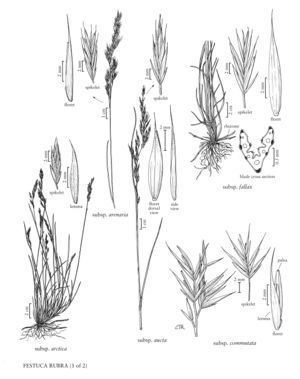Difference between revisions of "Festuca rubra subsp. arctica"
FNA>Volume Importer |
imported>Volume Importer |
||
| (7 intermediate revisions by 2 users not shown) | |||
| Line 7: | Line 7: | ||
|synonyms={{Treatment/ID/Synonym | |synonyms={{Treatment/ID/Synonym | ||
|name=Festuca rubra subsp. richardsonii | |name=Festuca rubra subsp. richardsonii | ||
| − | |authority= | + | |authority= |
| + | |rank=subspecies | ||
}} {{Treatment/ID/Synonym | }} {{Treatment/ID/Synonym | ||
|name=Festuca rubra var. mutica | |name=Festuca rubra var. mutica | ||
| − | |authority= | + | |authority= |
| + | |rank=variety | ||
}} {{Treatment/ID/Synonym | }} {{Treatment/ID/Synonym | ||
|name=Festuca rubra subsp. cryophila | |name=Festuca rubra subsp. cryophila | ||
| − | |authority= | + | |authority= |
| + | |rank=subspecies | ||
}} {{Treatment/ID/Synonym | }} {{Treatment/ID/Synonym | ||
|name=Festuca rubra var. alaica | |name=Festuca rubra var. alaica | ||
| − | |authority= | + | |authority= |
| + | |rank=variety | ||
}} {{Treatment/ID/Synonym | }} {{Treatment/ID/Synonym | ||
|name=Festuca richardsonii | |name=Festuca richardsonii | ||
| − | |authority= | + | |authority= |
| + | |rank=species | ||
}} | }} | ||
|hierarchy=Poaceae;Poaceae subfam. Pooideae;Poaceae tribe Poeae;Festuca;Festuca subg. Festuca;Festuca sect. Festuca;Festuca rubra;Festuca rubra subsp. arctica | |hierarchy=Poaceae;Poaceae subfam. Pooideae;Poaceae tribe Poeae;Festuca;Festuca subg. Festuca;Festuca sect. Festuca;Festuca rubra;Festuca rubra subsp. arctica | ||
| Line 40: | Line 45: | ||
-->{{#Taxon: | -->{{#Taxon: | ||
name=Festuca rubra subsp. arctica | name=Festuca rubra subsp. arctica | ||
| − | |||
|authority=(Hack.) Govor. | |authority=(Hack.) Govor. | ||
|rank=subspecies | |rank=subspecies | ||
| Line 47: | Line 51: | ||
|basionyms= | |basionyms= | ||
|family=Poaceae | |family=Poaceae | ||
| + | |illustrator=Cindy Roché | ||
| + | |illustration copyright=Utah State University | ||
|reference=None | |reference=None | ||
|publication title= | |publication title= | ||
|publication year= | |publication year= | ||
|special status= | |special status= | ||
| − | |source xml=https:// | + | |source xml=https://bitbucket.org/aafc-mbb/fna-data-curation/src/200273ad09963decb8fc72550212de541d86569d/coarse_grained_fna_xml/V24/V24_583.xml |
|subfamily=Poaceae subfam. Pooideae | |subfamily=Poaceae subfam. Pooideae | ||
|tribe=Poaceae tribe Poeae | |tribe=Poaceae tribe Poeae | ||
Latest revision as of 16:24, 11 May 2021
Plants rhizomatous, loosely to densely cespitose, with several culms arising from the same tuft. Culms (8)10-40(60) cm. Sheaths pubescent, slowly shredding into fibers; vegetative shoot blades (0.7)1-2 mm in diameter, usually conduplicate, veins 5-7(9), ribs 5(7), abaxial surfaces usually green, smooth or slightly scabrous, adaxial surfaces scabrous or pilose on the ribs; cauline blades usually conduplicate, sometimes flat; flag leaf blades usually (1.5)2-6 cm; abaxial sclerenchyma in 5-7 small strands; adaxial sclerenchyma rarely developed. Inflorescences (2)3.5-7 cm, sparsely branched panicles or racemes, well exserted, usually congested, sometimes open; branches usually stiff and erect, scabrous or pubescent. Spikelets (6)7-13 mm, mostly reddish or purplish, with (3)5-7 florets. Glumes ovate to ovate-lanceolate, acute to acuminate, often pilose near the apices; lower glumes (1.5)2.5-3.5(4) mm; upper glumes (3)3.5-5 mm; lemmas (4)4.5-6(6.5) mm, ovate to lanceolate, usually densely to moderately pilose, sometimes only partially pilose, rarely glabrous throughout, awned, awns (0.2)0.5-1.6(2.5) mm; anthers (2.3)2.5-3(3.7) mm. 2n = 42.
Discussion
Festuca rubra subsp. arctica grows in sands, gravels, silts, and stony soils of river banks, bars, and flats; in periglacial outwashes, beaches, sand dunes, muskegs, solifluction slopes, and scree slopes in tundra, subarctic forest, and barren regions; and subalpine areas in the mountains. It extends from Alaska, the southern part of the Canadian arctic archipelago, and Greenland to northwestern British Columbia, the coast of Hudson Bay and James Bay, and Quebec and Labrador, extending farthest south in the Rocky Mountains of Alberta. It also grows in arctic and subarctic Europe and Asia, and in the Ural Mountains.
Selected References
None.
